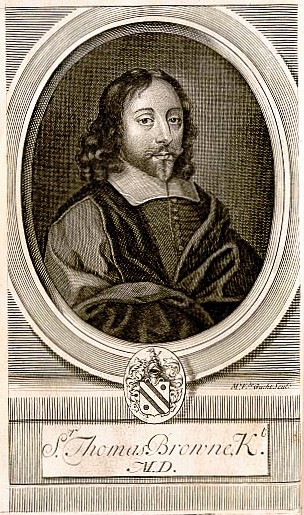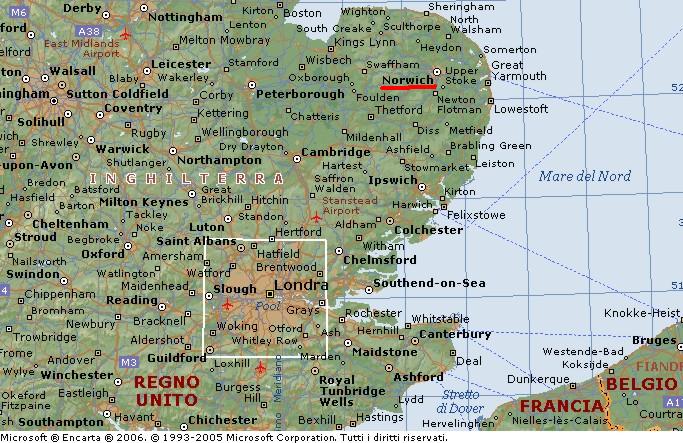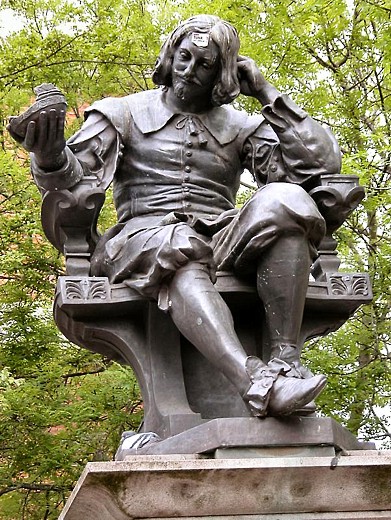Lessico
Thomas Browne

Thomas Browne (Londra 1605 - Norwich 1682) fu saggista e medico inglese. Dopo gli studi di medicina a Oxford, Montpellier, Leida e Padova, esercitò con grande competenza la professione medica, ma parallelamente si dedicò alla stesura di trattati, fra cui quello dal titolo Religio Medici (scritto probabilmente nel 1635), in cui scetticismo e teorie scientifiche si mescolano ad argomentazioni di fede e rivelazione.
Pseudodoxia Epidemica (1646), ponderosa raccolta di errori popolari, analizza le superstizioni più diffuse e ricorrenti. Nel 1658 furono date alle stampe due opere: Le urne sepolcrali, saggio sulla morte e sui costumi sepolcrali nel mondo, e Il giardino di Ciro, l'opera più singolare di Browne, che indaga il significato mistico del quinconce nella storia.
Il
quinconce, dal latino quincunx-uncis - quinque = 5 e uncia = oncia -, nella
Roma antica corrispondeva a 5/12 dell'asse![]() (cioè a 5 once) e più in generale di qualsiasi unità. L’asse romano era
una moneta di bronzo del valore di cinque once coniata in alcune città
italiche (Ariminum, Hatria, Luceria, Venusia, Teate) tra la fine del sec. IV e
la metà del sec. III a C, di peso vario secondo il sistema ponderale. La
rappresentazione simbolica di tale valore corrisponde a cinque punti disposti
come il 5 nei dadi.
(cioè a 5 once) e più in generale di qualsiasi unità. L’asse romano era
una moneta di bronzo del valore di cinque once coniata in alcune città
italiche (Ariminum, Hatria, Luceria, Venusia, Teate) tra la fine del sec. IV e
la metà del sec. III a C, di peso vario secondo il sistema ponderale. La
rappresentazione simbolica di tale valore corrisponde a cinque punti disposti
come il 5 nei dadi.


Statua di Thomas Browne a Norwich dove morì
Sir Thomas Browne (London October 19, 1605 – Norwich October 19, 1682) was an English author of varied works that disclose his wide learning in diverse fields including medicine, religion, science and the esoteric.
Browne's writings display a deep curiosity towards the natural world, influenced by the Scientific revolution of Baconian enquiry. In counterbalance his Christian faith exuded tolerance and goodwill towards humanity in an often intolerant era. A consummate literary craftsman, Browne's works are permeated by frequent reference to Classical and Biblical sources and to his own highly idiosyncratic personality. His literary style varies according to genre resulting in a rich, unusual prose that ranges from rough note-book observations to the highest baroque eloquence.
The son of a silk merchant from Upton, Cheshire, he was born in the parish of St Michael, Cheapside, in London on October 19, 1605. His father died while he was still young and he was sent to school at Winchester College. In 1623 Browne went up to Oxford University. He graduated from Pembroke College, Oxford in 1626 after which he studied medicine at various Continental universities, including Leiden, where he received an MD in 1633. He settled in Norwich in 1637 where he practiced medicine and lived until his death in 1682.
His first well-known work bore the Latin title Religio Medici (The Religion of a Physician). This work was circulated in manuscript among his friends, and it caused Browne some surprise and embarrassment when an unauthorised edition appeared in 1642, since the work contained a number of religious speculations that might be considered unorthodox. An authorised text with some of the controversial matter removed appeared in 1643. The expurgation did not end the controversy; in 1645, Alexander Ross attacked Religio Medici in his Medicus Medicatus (The Doctor, Doctored) and in fact the book was placed upon the Papal index of forbidden reading for Catholics in the same year.
In 1646, Browne published Pseudodoxia Epidemica, or, Enquiries into Very many Received Tenets, and commonly Presumed Truths, whose title refers to the prevalence of false beliefs and "vulgar errors." A sceptical work that debunks a number of legends circulating at the time in a paradoxical and witty manner, it displays the Baconian side of Browne—the side that was unafraid of what at the time was still called "the new learning." The book is significant in the history of science.
In 1658 Browne published together two Discourses which are intimately related to each other, the first Hydriotaphia, Urn Burial or a Brief Discourse of the Sepulchral Urns lately found in Norfolk, occasioned by the discovery of some Bronze Age burials in earthenware vessels found in Norfolk. These inspired Browne to meditate upon the funerary customs of the world and the fleetingness of earthly fame and reputation.
Urn-Burial's 'twin' Discourse is The Garden of Cyrus, or, The Quincunciall Lozenge, or Network Plantations of the Ancients, Artificially, Naturally, and Mystically Considered, whose slight subject is the quincunx, the arrangement of five units like the five-spot in dice, which Browne uses to demonstrate that the Platonic forms exist throughout Nature.
In 1671 King Charles II, accompanied by the Royal Court, visited Norwich. The courtier John Evelyn, who had occasionally corresponded with Browne, took good use of the Royal visit to call upon the learned doctor of European fame and wrote of his visit: His whole house & garden is a paradise and Cabinet of rarieties & that of the best collection, amongst Medails, books, Plants, natural things.
During his visit to Norwich, King Charles II visited Browne's home. A banquet was held in the Civic Hall St. Andrews for the Royal visit. Obliged to honour a notable local, the name of the Mayor of Norwich was proposed to the King for knighthood. The Mayor, however, declined the honour and proposed the name of Browne instead.
Sir Thomas Browne died on 19 October 1682, his 77th birthday. His skull became the subject of dispute when in 1840 his lead coffin was accidentally re-opened by workmen. It was not re-interred until 4 July 1922 when it was registered in the church of Saint Peter Mancroft as aged 316 years.
Literary works
Religio Medici (1643)
Pseudodoxia Epidemica (1646-72)
Hydriotaphia, Urn Burial (1658)
The Garden of Cyrus (1658)
A Letter to a Friend (1656; pub. post. 1690)
Christian Morals (1670s; pub. post. 1716)
Musaeum Clausum Tract 13 from Miscellaneous Tracts first pub. post. 1684
Literary influence
The literary critic Robert Sencourt succinctly assessed Browne as "an instance of scientific reason lit up by mysticism in the Church of England."
Indeed, Browne's paradoxical place in the history of ideas, as both a promoter of the new inductive science, as an adherent of ancient esoteric learning as well as devout Christian greatly contributes to his ambiguity in the history of ideas. Add to this the complexity of his labyrinthine thought and his ornate language, along with his many allusions to the Bible, Classical learning and to a variety of esoteric authors. These combined factors account for why Browne remains little-read and much-misunderstood. However, the influence of his literary style spans four centuries.
In the
eighteenth century, Doctor Johnson, who shared Browne's love of the Latinate,
wrote a brief Life in which he praised Browne as a faithful Christian.
In the nineteenth century Browne's reputation was revived by the Romantics.
Thomas De Quincey, Samuel Taylor Coleridge, and Charles Lamb (who considered
himself the rediscoverer of Browne) were all admirers. The seminal American
novelist Herman Melville, heavily influenced by his style, deemed him "a
cracked archangel."
The English author Virginia Woolf however wrote of him in 1923, "Few people love the writings of Sir Thomas Browne, but those that do are the salt of the earth."
In the twentieth century those who have admired the English man of letters include:
The
American natural historian and paleontologist Stephen Jay Gould
The Theosophist Madame Blavatsky
The Scottish psychologist R. D. Laing, who opens his work The Politics of Experience with a quotation by him.
The
composer William Alwyn wrote a symphony in 1973 based upon the rhythmical
cadences of Browne's literary work Hydriotaphia, Urn Burial.
The American author Tony Kushner in 1987 wrote a play upon Browne whose title
is Hydriotaphia.
The Canadian physician William Osler (1849-1919) the "founding father of modern medicine".
The German author W.G. Sebald wrote of Browne in his semi-autobiographical novel The Rings of Saturn (1995).
The Argentinian writer Jorge Luis Borges alluded to Browne throughout his literary writings, from his first publication, Fervor de Buenos Aires (1923) until his last years. Such was Borges' admiration of Browne as a literary stylist and thinker that late in his life (Interview April 25th 1980) he stated of himself alluding to his self-portrait in "Tlön, Uqbar, Orbis Tertius" (1940): "I am merely a word for Chesterton, for Kafka, and Sir Thomas Browne—I love him. I translated him into seventeenth century Spanish and it worked very well. We took a chapter out of Urne Buriall and we did that into Quevedo's Spanish and it went very well."
In his short story The Celestial Omnibus, published in 1911, E. M. Forster makes Browne the first "driver" that the young protagonist encounters on the magical omnibus line that transports its passengers to a place of direct experience of the aesthetic sublime reserved for those who internalize the experience of poetry.
In North Towards Home, Willie Morris quotes Sir Thomas Browne's Urn Burial from memory as he walks up Park Avenue with William Styron: "'And since death must be the Lucina of life, and even Pagans could doubt, whether thus to live were to die; since our longest sun sets at right descensions, and makes but winter arches, and therefore it cannot be long before we lie down in darkness and have our light in ashes...' At that instant I was almost clipped by a taxicab, and the driver stuck his head out and yelled, 'Aincha got eyes in that head, ya bum?'"